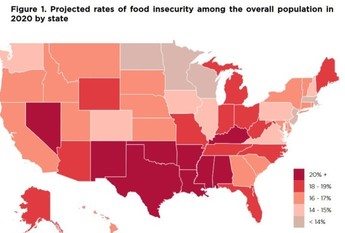
The Impact of Food Insecurity on Health
Food insecurity refers to a lack of available financial resources for food at the household level that disrupts food intake or eating patterns. These resources can include high housing costs, high unemployment, heavy tax burdens, lack of access to stores with foods for a healthy diet, and residential instability.
Food insecurity has a profound effect on the overall health of individuals; it correlates with those who have chronic health conditions of diabetes, hypertension, and obesity. Among children, food insecurity can lead to obesity, developmental problems, and negative effects on mental health. During the COVID-19 pandemic, the issue affects thousands of Iowans. For more about this important social determinant of health (SDOH), see Social Determinants of Health: Food Insecurity in the United States and SDOH Literature Summaries: Food Insecurity.

COVID-19 and Food Insecurity
Food insecurity extends beyond impoverished households. Families of many economic levels, affected by the COVID-19 pandemic, face the specter of food insecurity as well as hunger. According to Feeding America’s report, Impact of the Coronavirus on Local Food Security, an estimated 17 million more Americans, including 7 million more children are experiencing food insecurity. Much of the increase is coming from people who had never been to a food bank before—those who have newly lost a job or are supporting sick family members.
Using data from the US Census Bureau Pulse Survey, in June 2020, Northwestern University researchers concluded that food insecurity has doubled overall and tripled among households with children. Estimates of the increase during the pandemic “may be understated.” How Much Has Food Insecurity Risen? Evidence from the Census Household Pulse Survey
What Food Insecurity Looks Like in Iowa
In 2018, Feeding America estimated 305,100 Iowans or 1 in 10 struggled with hunger and, of them, 102,190 were children. Feeding America estimates for 2020 were 33% higher for all Iowans (100,000 more people) and 44% higher for children (44,510 more children). Estimates for Iowa and each county are available at https://www.feedingamericaaction.org/the-impact-of-coronavirus-on-food-insecurity/.
|

Healthy Iowans: Iowa’s Health Improvement Plan 2017-2021
Prior to the onset of COVID-19, Iowa had made progress in decreasing the overall percentage of Iowans and children who were food insecure, but not for adults ages 60+. Additional strategies to address food insecurity now are of critical importance during the pandemic.
Existing Strategies in Healthy Iowans to Reduce Food Insecurity
- Increase Double Up Food Bucks at farmer’s markets (Obesity, Nutrition & Physical Activity (ONPA) Strategy 2-1.2, p. 186)
- Increase the number of children participating in the Supplemental Nutrition Assistance Program (ONPA Strategy 2-1.4, p. 187)
- Increase the consumption of fruits and vegetables in high nutrition-risk congregate meal participants (ONPA Strategy 2-1.6, p. 187)
- Increase the number of summer meal sites (ONPA Objective 2-4, p. 189)
|

Implementing Local Partnerships in Health Improvement Plans
Dallas, Lee, and Story counties have developed innovative partnership strategies to address food insecurity.
Lee County helped overcome the problem of food deserts for its rural elderly population by establishing seven sites where local food producers, growers, and farmer’s market vendors donate produce.
In Dallas County, the Dallas County Food GRID established a Pop Up Produce stand in communities lacking optimal grocery options. Produce sells at wholesale prices. Another program, geared to older adults, the Senior Produce Box program, delivers fresh fruit and vegetables to anyone over 60 years old who can purchase the boxes with vouchers.
In Story County, the Hunger Collaboration developed the BackPack program serving hundreds of children in school districts across the county. The United Way of Story County supports families facing hunger by providing transportation and offering sliding fee scales to families for day care for their children and adult services for their aging parents.
Additional Resources
Berkowitz, Seth A., et al. “State-Level and County-Level Estimates of Health Care Costs Associated with Food Insecurity.” Preventing Chronic Disease, vol. 16, July 2019, p. 180549. DOI.org (Crossref), doi: 10.5888/pcd16.180549.
Ettinger de Cuba, Stephanie, et al. “Loss Of SNAP Is Associated With Food Insecurity And Poor Health In Working Families With Young Children.” Health Affairs, vol. 38, no. 5, May 2019, pp. 765–73. DOI.org (Crossref), doi: 10.1377/hlthaff.2018.05265.
Gundersen, Craig, and James P. Ziliak. “Food Insecurity And Health Outcomes.” Health Affairs, vol. 34, no. 11, Health Affairs, Nov. 2015, pp. 1830–39, doi:10.1377/hlthaff.2015.0645.
Ivers, Louise C., and Kimberly A. Cullen. “Food Insecurity: Special Considerations for Women.” The American Journal of Clinical Nutrition, vol. 94, no. 6, Dec. 2011, pp. 1740S-1744S. DOI.org (Crossref), doi: 10.3945/ajcn.111.012617
|
|